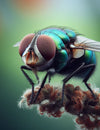Cockroaches are among the most resilient and persistent pests, and two of the most common species that often invade homes and businesses are the American cockroach (Periplaneta americana) and the German cockroach (Blattella germanica). While they share the same uninviting reputation, these two species differ in various aspects, from size to behavior. In this blog post, we will delve into the characteristics, habits, and challenges associated with the American and German cockroaches, and explore effective control methods, including the use of "cockroach killer gel" to combat these unwelcome intruders.
Physical Characteristics:
- American Cockroach: Also known as the "palmetto bug" or "water bug," the American cockroach is the largest among common cockroach species. Adults can grow up to 1.5 inches in length, and they are reddish-brown in color with a distinctive yellowish figure-eight pattern on their head.
- German Cockroach: German cockroaches are significantly smaller, typically ranging from 0.5 to 0.6 inches in length. They are light brown to tan and have two dark stripes running parallel down their back.
Habitat and Distribution:
-
American Cockroach: This species prefers warm and damp environments, often found in basements, sewers, and other humid areas. They are more common in the southern United States but can be found throughout the country.
- German Cockroach: German cockroaches thrive in indoor environments, especially in kitchens and bathrooms. They are more adaptable to colder climates and can be found worldwide, making them one of the most widespread and troublesome pests.
Reproduction and Lifecycle:
- American Cockroach: American cockroaches have a longer lifecycle compared to their German counterparts. The female can lay up to 16 eggs at a time, and it takes about 6-8 weeks for the eggs to hatch into nymphs. The nymphs then go through several molts before reaching adulthood.
- German Cockroach: German cockroaches reproduce at a faster rate. A single female can produce up to 40 eggs at a time, and the development from egg to adult takes about 50-60 days. This rapid reproduction contributes to their ability to establish large infestations quickly.
Behavior and Activity:
- American Cockroach: These roaches are more likely to be active outdoors, especially in warm weather. They are competent fliers and are attracted to light. American cockroaches are also known for their distinctive hissing sound when disturbed.
- German Cockroach: German cockroaches are primarily indoor pests, preferring to stay close to food and water sources. They are excellent climbers and are often found in and around kitchens and bathrooms.
Health Risks and Control:
- American Cockroach: While American cockroaches are not as commonly associated with indoor infestations, they can still pose health risks by contaminating food and surfaces. Control measures involve eliminating water sources, sealing entry points, and using insecticides as needed.
- German Cockroach: These roaches are notorious for spreading diseases and triggering allergies. Effective control involves a combination of proper sanitation, removing food sources, and using targeted insecticides. Due to their rapid reproduction, professional pest control may be necessary for severe infestations.
Conclusion:
Both the American cockroach and the German cockroach are resilient pests with distinct characteristics that influence their behavior, habitat preferences, and the methods required for effective control. Understanding these differences is crucial for implementing targeted pest management strategies and maintaining a roach-free environment. Whether you're dealing with the large, outdoor-dwelling American cockroach or the smaller yet more adaptable German cockroach, early intervention and comprehensive pest control measures are essential for keeping these unwanted guests at bay.



